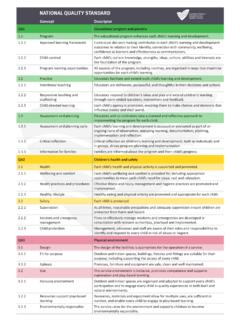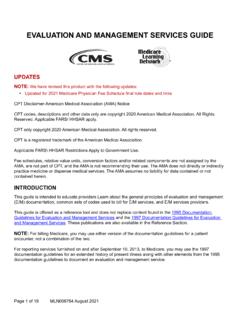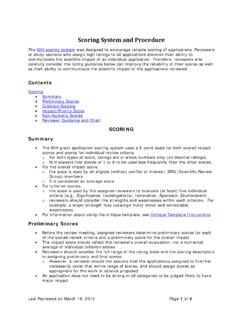Transcription of CRISP-DM 1
1 CRISP-DM Step-by-step data mining guide Pete Chapman (NCR), Julian Clinton (SPSS), Randy Kerber (NCR), Thomas Khabaza (SPSS), Thomas Reinartz (DaimlerChrysler), Colin Shearer (SPSS) and R diger Wirth (DaimlerChrysler). SPSS is a registered trademark and the other SPSS products named are trademarks of SPSS Inc. All other names are trademarks of their respective owners. 2000 SPSS Inc. CRISPMWP-1104. This document describes the CRISP-DM process model and contains information about the CRISP-DM methodology, the CRISP-DM reference model, the CRISP-DM user guide, and the CRISP-DM reports, as well as an appendix with additional related information. This document and information herein are the exclusive property of the partners of the CRISP-DM . consortium: NCR Systems Engineering Copenhagen (USA and Denmark), DaimlerChrysler AG (Germany), SPSS Inc. (USA), and OHRA Verzekeringen en Bank Groep (The Netherlands). Copyright 1999, 2000. All trademarks and service marks mentioned in this document are marks of their respective owners and are as such acknowledged by the members of the CRISP-DM consortium.
2 CRISP-DM Foreword CRISP-DM was conceived in late 1996 by three veterans of the young and immature data mining market. DaimlerChrysler (then Daimler-Benz) was already ahead of most industrial and commercial organizations in applying data mining in its business operations. SPSS (then ISL) had been providing services based on data mining since 1990 and had launched the first commercial data mining workbench Clementine in 1994. NCR, as part of its aim to deliver added value to its Teradata data warehouse customers, had established teams of data mining consultants and technology specialists to service its clients' requirements. At that time, early market interest in data mining was showing signs of exploding into widespread uptake. This was both exciting and terrifying. All of us had developed our approaches to data mining as we went along. Were we doing it right? Was every new adopter of data mining going to have to learn, as we had initially, by trial and error?
3 And from a supplier's perspective, how could we demonstrate to prospective customers that data mining was sufficiently mature to be adopted as a key part of their business processes? A standard process model, we reasoned, non-proprietary and freely available, would address these issues for us and for all practitioners. A year later, we had formed a consortium, invented an acronym (CRoss-Industry Standard Process for Data Mining), obtained funding from the European Commission, and begun to set out our initial ideas. As CRISP-DM was intended to be industry-, tool-, and application-neutral, we knew we had to get input from as wide a range as possible of practitioners and others (such as data warehouse vendors and management consultancies) with a vested interest in data mining. We did this by creating the CRISP-DM Special Interest Group ( The SIG, as it became known). We launched the SIG by broadcasting an invitation to interested parties to join us in Amsterdam for a day-long workshop: We would share our ideas, invite them to present theirs, and openly discuss how to take CRISP-DM forward.
4 On the day of the workshop, there was a feeling of trepidation among the consortium members. Would no one be interested enough to show up? Or, if they did, would they tell us they really didn't see a compelling need for a standard process? Or that our ideas were so far out of step with others' that any idea of standardization was an impractical fantasy? The workshop surpassed all our expectations. Three things stood out: Twice as many people turned up as we had initially expected There was an overwhelming consensus that the industry needed a standard process and needed it now As attendees presented their views on data mining from their project experience, it became clear that although there were superficial differences mainly in demarcation of phases and in terminology there was tremendous common ground in how they viewed the process of data mining CRISP-DM 1. By the end of the workshop, we felt confident that we could deliver, with the SIG's input and critique, a standard process model to service the data mining community.
5 Over the next two and a half years, we worked to develop and refine CRISP-DM . We ran trials in live, large-scale data mining projects at Mercedes-Benz and at our insurance sector partner, OHRA. We worked on the integration of CRISP-DM with commercial data mining tools. The SIG proved invaluable, growing to over 200 members and holding workshops in London, New York, and Brussels. By the end of the EC-funded part of the project mid-1999 we had produced what we considered a good-quality draft of the process model. Those familiar with that draft will find that a year later, although now much more complete and better presented, CRISP-DM is by no means radically different. We were acutely aware that, during the project, the process model was still very much a work-in-progress; CRISP-DM had only been validated on a narrow set of projects. Over the past year, DaimlerChrysler had the opportunity to apply CRISP-DM to a wider range of applications. SPSS' and NCR's Professional Services groups have adopted CRISP-DM and used it successfully on numerous customer engagements covering many industries and business problems.
6 Throughout this time, we have seen service suppliers from outside the consortium adopt CRISP-DM , repeated references to it by analysts as the de facto standard for the industry, and a growing awareness of its importance among customers ( CRISP-DM . is now frequently referenced in invitations to tender and in RFP documents). We believe our initiative has been thoroughly vindicated, and while future extensions and improvements are both desirable and inevitable, we consider CRISP-DM Version sufficiently validated to be published and distributed. CRISP-DM has not been built in a theoretical, academic manner working from technical principles, nor did elite committees of gurus create it behind closed doors. Both these approaches to developing methodologies have been tried in the past, but have seldom led to practical, successful, and widely adopted standards . CRISP-DM succeeds because it is soundly based on the practical, real-world experience of how people conduct data mining projects.
7 And in that respect, we are overwhelmingly indebted to the many practitioners who contributed their efforts and their ideas throughout the project. The CRISP-DM consortium August 2000. 2 CRISP-DM Table of contents I Introduction .. 6. 1 The CRISP-DM methodology .. 6. Hierarchical breakdown .. 6. Reference model and user guide .. 7. 2 Mapping generic models to specialized models .. 7. Data mining context .. 7. Mappings with contexts .. 8. How to map .. 8. 3 Description of parts ..9. Contents .. 9. Purpose .. 9. II The CRISP-DM reference model .. 10. 1 Business understanding .. 13. Determine business objectives .. 14. Assess situation .. 14. Determine data mining goals .. 16. Produce project plan .. 16. 2 Data understanding .. 17. Collect initial data .. 18. Describe data .. 18. Explore data .. 18. Verify data quality .. 19. 3 Data preparation .. 20. Select data .. 21. Clean data .. 21. Construct data .. 21. Integrate data .. 22. Format data.
8 22. CRISP-DM 3. 4 Modeling .. 23. Select modeling technique .. 24. Generate test design .. 24. Build model .. 24. Assess model .. 25. 5 Evaluation .. 26. Evaluate results .. 26. Review process .. 27. Determine next steps .. 27. 6 Deployment .. 28. Plan deployment .. 28. Plan monitoring and maintenance .. 29. Produce final report .. 29. Review project .. 29. III The CRISP-DM user guide .. 30. 1 Business understanding .. 30. Determine business objectives .. 30. Assess situation .. 32. Determine data mining goals .. 35. Produce project plan .. 36. 2 Data understanding .. 37. Collect initial data .. 37. Describe data .. 39. Explore data .. 40. Verify data quality .. 41. 3 Data preparation .. 42. Select data .. 42. Clean data .. 43. Construct data .. 44. Integrate data .. 46. Format data .. 46. 4 CRISP-DM 4 Modeling .. 47. Select modeling technique ..47. Generate test design .. 49. Build model .. 49. Assess model .. 50. 5 Evaluation .. 51. Evaluate results.
9 52. Review process .. 53. Determine next steps .. 53. 6 Deployment .. 54. Plan deployment .. 54. Plan monitoring and maintenance .. 55. Produce final report .. 55. Review project .. 56. IV The CRISP-DM outputs .. 57. 1 Business understanding .. 57. 2 Data understanding .. 58. 3 Data preparation .. 60. 4 Modeling .. 60. 5 Evaluation .. 62. 6 Deployment .. 62. 7 Summary of dependencies .. 64. V Appendix .. 65. 1 Glossary/terminology .. 65. 2 Data mining problem types .. 66. Data description and summarization .. 66. Segmentation .. 67. Concept descriptions .. 68. Classification .. 69. Prediction .. 70. Dependency analysis .. 70. CRISP-DM 5. Introduction The CRISP-DM methodology Hierarchical breakdown The CRISP-DM methodology is described in terms of a hierarchical process model, consisting of sets of tasks described at four levels of abstraction (from general to specific): phase, generic task, specialized task, and process instance (see figure 1).
10 At the top level, the data mining process is organized into a number of phases; each phase consists of several second-level generic tasks. This second level is called generic because it is intended to be general enough to cover all possible data mining situations. The generic tasks are intended to be as complete and stable as possible. Complete means covering both the whole process of data mining and all possible data mining applications. Stable means that the model should be valid for yet unforeseen developments like new modeling techniques. The third level, the specialized task level, is the place to describe how actions in the generic tasks should be carried out in certain specific situations. For example, at the second level there might be a generic task called clean data. The third level describes how this task differs in different situations, such as cleaning numeric values versus cleaning categorical values, or whether the problem type is clustering or predictive modeling.




